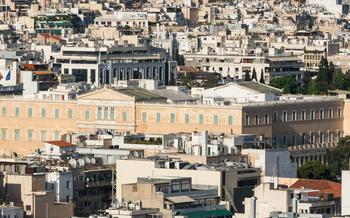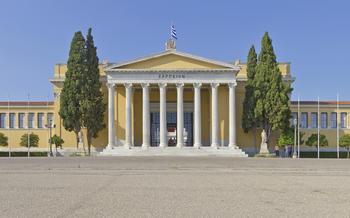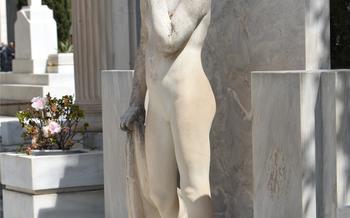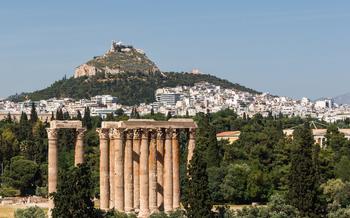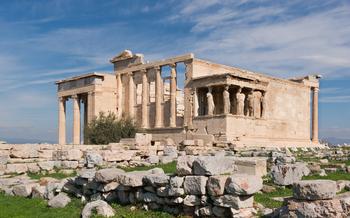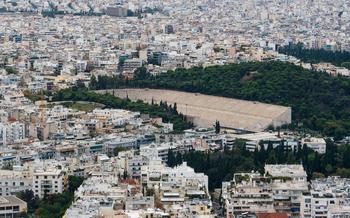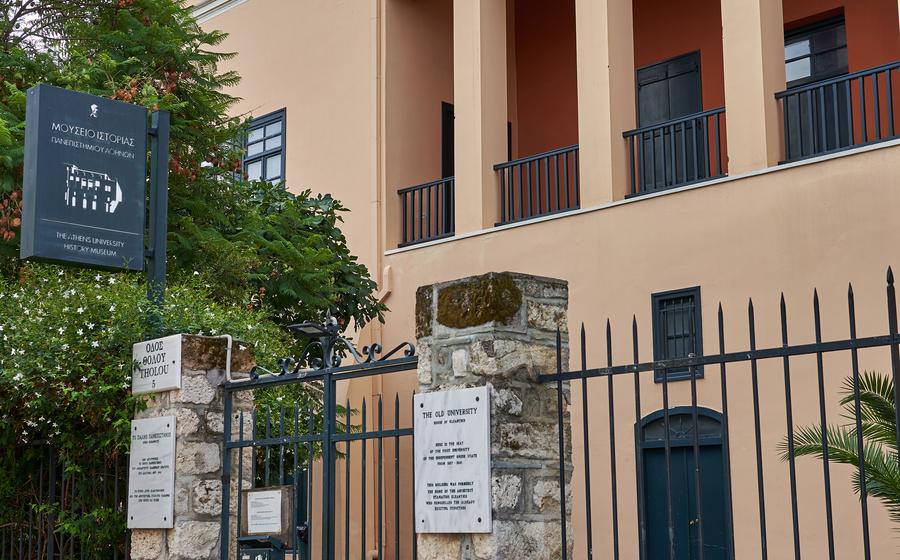
Museum for the History of the University of Athens
- History of the University of Athens Museum
- Collections and Exhibits
- Education and Research
- Architecture and Design
- Temporary Exhibitions
- Visitor Experience
- Guided Tours
- Educational Resources
- Hours of Operation
- Location and Transportation
- Food and Drinks:
- Accessibility
- Sustainability and Green Initiatives
- A Hidden Gem in the Heart of Academia:
History of the University of Athens Museum
The University of Athens Museum stands as a testament to the rich history and legacy of one of Greece's most prestigious academic institutions. Founded in 1837, the university played a pivotal role in shaping modern Greek society and establishing the foundations of higher education in the country. The museum, established within the university campus, serves as a repository of knowledge and artifacts that narrate the university's journey through the years.
Its exhibits showcase the evolution of academic disciplines, the contributions of renowned scholars, and the impact of the university's research on various fields. The museum's location within the university campus symbolizes the inseparable link between the institution's past, present, and future, making it an integral part of the university's identity and heritage.
Among the unique aspects of the museum's history is its close association with prominent figures who have graced the halls of the university. Visitors can explore the personal belongings, manuscripts, and memorabilia of notable professors, scientists, and intellectuals who have left an indelible mark on Greek academia and beyond. These artifacts provide a glimpse into the lives and minds of those who shaped the university's intellectual landscape.
Collections and Exhibits
The Museum for the History of the University of Athens houses a diverse collection of artifacts and exhibits that narrate the university's illustrious past and its significant contributions to Greek academia. Visitors can delve into the rich history of the institution through various exhibits that showcase original documents, photographs, scientific instruments, student records, and rare publications. Of particular note are the personal effects and manuscripts of renowned Greek scholars and professors, offering a glimpse into their academic pursuits and achievements. The museum also features interactive displays and multimedia presentations that bring to life the university's evolution over the centuries. These engaging exhibits not only provide historical insights but also highlight the university's ongoing commitment to academic excellence and innovation.
Education and Research
The Museum for the History of the University of Athens plays a crucial role in supporting education and research at the university. It offers a range of educational programs, workshops, and events designed to engage students, researchers, and the general public. These programs often collaborate with academic departments and research centers within the university, fostering interdisciplinary dialogue and knowledge exchange.
The museum also provides opportunities for visitors to engage in research or learning experiences. Its collections and exhibits serve as a valuable resource for students and researchers conducting historical or cultural studies related to the university or the broader field of higher education. The museum's staff is knowledgeable and enthusiastic, providing guidance and assistance to visitors seeking to explore the museum's resources.
By fostering a vibrant environment for learning and research, the Museum for the History of the University of Athens contributes significantly to the intellectual and cultural life of the university and the wider community. It serves as a bridge between the past and the present, connecting the university's rich history with its ongoing mission of education and scholarship.
Architecture and Design
The Museum for the History of the University of Athens is housed in a beautiful neoclassical building designed by the renowned Danish architect Theophil Hansen. Built in 1842, the building originally served as the university's central library. The museum's architecture is a testament to the university's rich history and its commitment to classical ideals.
The building's exterior is characterized by its symmetrical facade, adorned with elegant columns and pediments. The interior features a grand staircase, vaulted ceilings, and intricately painted walls. The museum's design creates a sense of grandeur and solemnity, befitting its role as a repository of the university's history.
The interior spaces of the museum are organized around a central courtyard, which floods the museum with natural light. The exhibits are arranged in chronological order, allowing visitors to trace the development of the university from its founding to the present day. The museum's design also incorporates modern elements, such as interactive displays and multimedia presentations, which enhance the visitor experience and make the history of the university come alive.
The Museum for the History of the University of Athens is not just a repository of artifacts but also a work of art in its own right. Its architecture and design are integral to its mission of preserving and showcasing the university's rich history and traditions.
Temporary Exhibitions
The Museum for the History of the University of Athens hosts a dynamic program of temporary exhibitions that complement its permanent collection and explore diverse themes related to the university's history and influence on Greek society. These exhibitions provide a platform for showcasing unique artifacts, research findings, and collaborations with other institutions.
Temporary exhibitions at the museum have covered a wide range of topics, including the history of student life in Athens, the contributions of notable alumni to various fields, and the evolution of academic disciplines within the university. Past exhibitions have featured rare photographs, manuscripts, scientific instruments, and artwork that shed light on the university's rich history and its impact on Greek culture.
Upcoming and current temporary exhibitions at the museum are announced on its website and social media channels. Visitors are encouraged to check the museum's calendar before their visit to learn about the latest exhibitions and plan their visit accordingly. These temporary exhibitions offer a fresh perspective on the university's history and provide an opportunity for visitors to engage with new and thought-provoking content.
Visitor Experience
The Museum for the History of the University of Athens offers a welcoming and informative experience for visitors of all ages and interests. As you enter the museum, you'll be greeted by friendly staff who can provide you with maps, brochures, and guidance to help you navigate the exhibits. The museum's layout is well-organized, allowing visitors to flow through the galleries at their own pace.
The exhibits are presented in a clear and concise manner, with informative labels and descriptions that enhance the visitor's understanding of the university's history and its significance. Interactive displays and multimedia presentations bring the exhibits to life, engaging visitors and providing a memorable learning experience. The museum also offers guided tours, which provide visitors with deeper insights and knowledge about the university's history and the artifacts on display. These tours are led by experienced guides who are passionate about sharing the story of the university and its impact on Greek society and culture.
Guided Tours
The Museum for the History of the University of Athens offers guided tours to enhance the visitor experience and provide deeper insights into the museum's collections and exhibits. These tours are led by knowledgeable and experienced guides who can share their expertise and answer any questions visitors may have.
Different types of tours are available to accommodate the interests and needs of various visitors. General tours provide a comprehensive overview of the museum's history, collections, and significance. Thematic tours focus on specific aspects or periods of the university's history, such as its founding, notable figures, or academic achievements. Specialized tours are tailored to particular audiences, such as students, researchers, or history enthusiasts.
Taking a guided tour offers several benefits. Visitors can gain a deeper understanding of the museum's exhibits and their historical context. The guides can provide additional information and anecdotes that may not be readily available in the written descriptions. Guided tours also allow visitors to ask questions and engage in discussions with the guide and other participants.
To ensure a spot on a guided tour, reservations are recommended, especially for groups or during peak tourist seasons. Visitors can book tours through the museum's website or by contacting the museum directly. The museum's staff is happy to assist with reservations and provide additional information about the available tours.
Educational Resources
The Museum for the History of the University of Athens offers a range of educational resources to enhance the visitor experience and promote learning. Visitors can access informative brochures and guides that provide detailed information about the museum's exhibits and collections. These resources are available in multiple languages to cater to a diverse audience. Additionally, the museum's website serves as a valuable resource, featuring virtual tours, educational materials, and in-depth articles on various aspects of the university's history.
For researchers and students, the museum collaborates with academic departments and research centers to provide specialized resources and support. Access to rare documents, manuscripts, and archival materials is available upon request, enabling scholars to conduct in-depth research on the history of the university and its contributions to various fields of knowledge. The museum's commitment to education extends beyond its physical space, as it actively engages with schools and educational institutions through outreach programs and workshops. These initiatives aim to inspire young minds, foster a love for learning, and promote the preservation of Greece's rich cultural heritage.
Hours of Operation
The Museum for the History of the University of Athens typically adheres to regular hours of operation, ensuring accessibility to visitors throughout the week. During weekdays, the museum is generally open from [time] to [time], allowing ample time for exploration and learning. On weekends, the museum maintains similar hours, providing flexibility for those seeking a leisurely visit. However, it is important to note that seasonal variations may occur, particularly during peak tourist seasons or holidays. During these times, the museum may extend its hours or offer special late-night openings to accommodate the influx of visitors. Conversely, there may be occasional closures or restricted access periods due to maintenance, renovations, or special events. To avoid any inconvenience, it is advisable to consult the museum's website or contact them directly for the most up-to-date information regarding their hours of operation.
Location and Transportation
The Museum for the History of the University of Athens is conveniently located within the university campus, in the heart of the city's vibrant academic district. Visitors can easily reach the museum using public transportation, with the nearest metro station, "Panepistimio," just a short walk away. Several bus and tram lines also stop nearby, providing direct connections to other parts of the city. For those arriving by car, limited parking is available on the university campus, and several public parking facilities are located within walking distance. The museum's central location makes it an accessible and convenient destination for visitors exploring the historic and cultural landmarks of Athens.
Food and Drinks:
The Museum for the History of the University of Athens does not have a dedicated café or restaurant within its premises. However, visitors can find a variety of dining options nearby. The surrounding university campus offers a selection of cafeterias and eateries catering to students and staff. Visitors can grab a quick bite, a refreshing drink, or a leisurely meal at these establishments.
For those seeking more diverse culinary experiences, the vibrant neighborhood of Exarchia, just a short walk from the museum, offers a plethora of restaurants, cafés, and tavernas. From traditional Greek cuisine to international flavors, there's something to satisfy every palate. Whether you're in the mood for a hearty moussaka, a juicy souvlaki, or a flavorful pasta dish, Exarchia's culinary scene has you covered.
When visiting the museum, it's important to be mindful of any restrictions or policies regarding food and drinks inside the exhibition spaces. To preserve the artifacts and maintain a clean and respectful environment, visitors may be asked to refrain from consuming food or beverages in certain areas. Please be sure to follow the guidelines provided by the museum staff to ensure a pleasant and enjoyable visit.
Accessibility
The Museum for the History of the University of Athens is committed to ensuring accessibility for all visitors, regardless of their abilities. Wheelchair ramps and elevators are available throughout the museum, making all exhibits and facilities easily accessible. Accessible restrooms are also available for the convenience of visitors.
In addition to physical accessibility, the museum also offers a variety of services and accommodations for visitors with disabilities. Staff members are trained to assist visitors with disabilities and can provide information in alternative formats, such as Braille or large print. Audio guides and transcripts are available for all exhibits, and sign language interpretation can be arranged upon request.
The museum's website provides detailed accessibility information, including maps and descriptions of accessible routes. Visitors can also contact the museum in advance to inquire about specific accessibility needs.
Sustainability and Green Initiatives
The Museum for the History of the University of Athens is committed to sustainability and implementing green practices throughout its operations. The museum utilizes renewable energy sources, such as solar panels, to reduce its environmental impact. It also has waste reduction initiatives in place, including recycling programs for paper, plastic, and electronic waste.
Within its exhibits, the museum highlights educational programs and exhibits related to environmental sustainability. These exhibits showcase the importance of preserving natural resources, reducing waste, and adopting green technologies. The museum has received recognition for its sustainability efforts, earning awards from the Greek Ministry of Environment and Energy for its green practices.
A Hidden Gem in the Heart of Academia:
Delving into the depths of the Museum for the History of the University of Athens, visitors may stumble upon a hidden gem: a remarkable artifact that holds a fascinating tale. Among the numerous treasures, one stands out—a rare and precious manuscript that sheds light on the university's rich history. This ancient document, carefully preserved within the museum's vaults, offers a glimpse into the institution's founding principles, struggles, and triumphs, inviting visitors to embark on a journey through time and discover the captivating narrative of one of Greece's most esteemed academic institutions.
